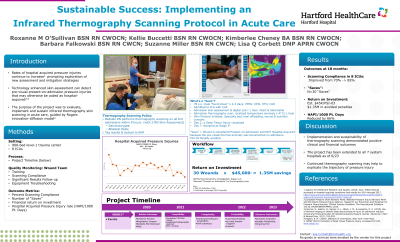Practice Innovations
(PI-017) Sustainable Success: Implementing an Infrared Thermography Scanning Protocol in Acute Care

Nationwide, rates of hospital acquired pressure injuries continue to increase (AHRQ, 2020). Technology enhanced skin assessment, such as infrared thermography, can detect pre-visual present on admission pressure injuries that may otherwise be coded as hospital-acquired (EPUAP/NPIAP/PPPIA; 2019; Koerner et al., 2019). This project applied Rogers’ innovation-diffusion model to guide the evaluation, implementation, and maintenance of a new wound technology (2003).
Methods:
Following a successful pilot, infrared thermography was implemented at this 900-bed level one trauma center in September 2021. The technology was deployed in all eight critical care units. New admissions were scanned within eight hours of arrival by the bedside registered nurse (RN), in addition to a two-RN skin assessment. Prior to launch, nurses received remote and in-person education on the use of infrared thermography. Unit based super-users received additional training. The project was scaffolded by the wound team including quality monitoring and ongoing educational support. Outcome measures included: compliance with hospital protocol, number of “saves” (pre-visual present-on-admission pressure injuries evolving to full thickness), financial return on investment, and pressure injury rate.
Results:
During the 18-month period post-launch compliance with infrared thermography protocol has consistently improved, rising from 70.1% to 85.2%. Thirty “saves” were identified during this period. This has resulted in an estimated return on investment of $1,350,000, considering potential regulatory penalties for hospital acquired pressure injuries. Hospital acquired pressure injury rate reduced by 56% during the studied period. Successful project outcome has resulted in roll-out to five system hospitals.
Discussion:
Evaluating an institution’s readiness prior to launch, implementation with attention to organizational drivers, and maintenance of standard protocol using quality measures is essential for successful outcomes. An evidence-based innovation-diffusion model can guide technology adoption in a healthcare setting.
Trademarked Items:
References: 1. Agency for Healthcare Research and Quality. (2020, July). AHRQ national scorecard on hospital-acquired conditions final results for 2014 through 2017. https://www.ahrq.gov/sites/default/files/wysiwyg/professionals/quality-patient-safety/pfp/Updated-hacreportFInal2017data.pdf
2. European Pressure Ulcer Advisory Panel, National Pressure Injury Advisory Panel and Pan Pacific Pressure Injury Alliance. Haesler E, ed. Prevention and Treatment of Pressure Ulcers/Injuries: Clinical Practice Guideline. The International Guideline. 3rd ed. EPUAP/NPIAP/PPPIA; 2019.
3. Koerner, S., Adams, D., Harper, S. L., Black, J. M., & Langemo, D. K. (2019) Use of thermal imaging to identify deep-tissue pressure injury on admission reduces clinical and financial burden of hospital-acquired pressure injuries. Advances in Skin & Wound Care, 32(7), 312-320. doi: 10.1097/01.ASW.0000559613.83195.f9
4. Rogers, E. M. (2003). Diffusion of innovations. New York: Free Press.

.png)
